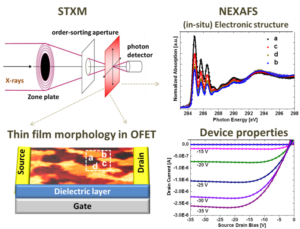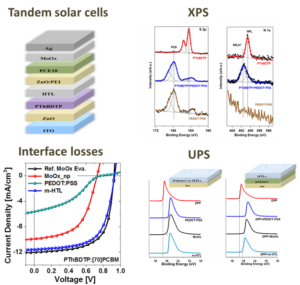Xiaoyan Du
Dr. rer. nat. Xiaoyan Du
Project description
In my PhD research project, the focus has been devoted to active layer morphology and interface engineering in organic electronics including organic field-effect transistors (OFETs) and organic solar cells (OSCs) using complementary characterization techniques including soft X-ray based near-edge X-ray absorption fine structure (NEXAFS) spectroscopy, scanning transmission X-ray microscopy (STXM), X-ray and ultra-violet photoelectron spectroscopy (XPS/UPS), chemically sensitive resonant soft X-ray scattering and TEM.
The charge transport and its relation to the micro-/nanoscopic structure as well as the molecular packing in thin-film OFETs are remaining challenging topics [1]. Structural polymorphs and more importantly grain/domain boundaries are sources for trap states reducing the charge-carrier mobilities [2,3]. NEXAFS and STXM reveal the crystalline domain size and the molecular orientations as shown in Fig. 1. Electric field-effect on the electronic structures of organic molecules are monitored by in-situ/in-operando NEXAFS measurements [4]. The experiments are supported by theoretical calculations to obtain insight into the effect of molecular polarizations and detailed understanding of spectral features in the NEXAFS spectra.
In single- and multi-junction organic solar cells, chemical interactions and energy-level alignments at the interfaces are of paramount importance for charge carrier injection and extraction [5]. Using photoemission spectroscopy we are able to analyse the electronic levels and interface reactions to derive potential pathways for interfacial losses, which is particularly crucial for device engineering as depicted in Fig. 2 [6]. The chemistry related to device stability as well as the processing parameters, e.g. thermal annealing, is further elucidated through in-situ XPS and UPS measurements.

Fig. 1: STXM and (In-situ) NEXAFS investigations of OFET thin film morphology and electronic structures.

Fig. 2: Interface losses analysis of organic solar cells (taken from ref. [6])
References
[1] V. Coropceanu et al., Chem. Rev. 107 (2007) 926.
[2] S. S. Lee et al., Annu. Rev. Chem. Biomol. Eng. 1 (2010) 59.
[3] B. Rösner et al., Org. Electron. 15 (2014) 435.
[4] C. Hub et al., J. Mater. Chem. 20 (2010) 4884.
[5] J. Meyer, et al., Adv. Mater. 24, (2012) 5408.
[6] X. Du et al., Adv. Energy Mater. 7 (2016) 1601959.

